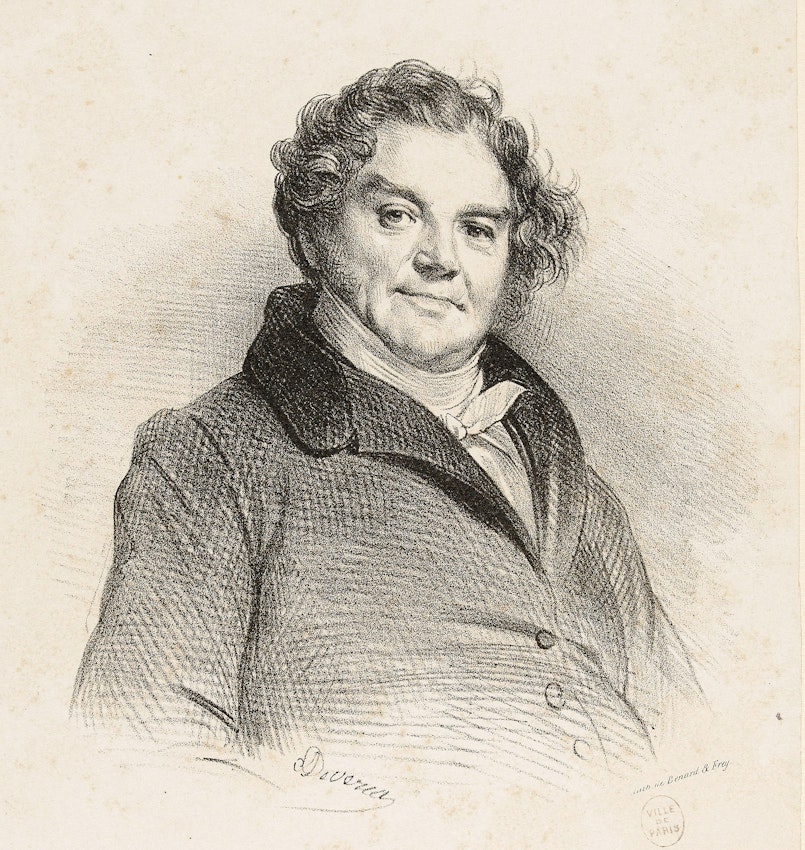 Scroll through the whole page to download all images before printing.
Scroll through the whole page to download all images before printing.
Lithograph portrait of Eugène-François Vidocq by Achille Devéria, ca. 1828 — Source.
When the Brigade de Sûreté was set up in Paris in 1812, it was a first of its kind: a criminal investigation bureau composed of undercover officers, which would later evolve into France’s national police force. At a time when institutionalised policing was still in its infancy, the Sûreté provided the blueprint for Scotland Yard, established in 1829, and the FBI a century later. At its head, one might imagine someone akin to the men who would follow in this bureau chief’s footsteps: Robert Peel, the Conservative politician and future prime minister who first put Britain’s “bobbies” on the beat, or J. Edgar Hoover, a law student who rose through the ranks of the Justice Department to serve as the American federal agency’s first director. Eugène-François Vidocq (1775–1857), the Sûreté’s founding chief, was nothing of the kind. After a youth of petty criminality, he spent the first fifteen years of his adult life either in prison or on the run, leaving him with little time to pursue a political career. And for a man more at home donning disguises and planning daring jailbreaks, administration wasn’t really his thing.
Vidocq’s tale — one of con man turned detective, poacher turned gamekeeper, the criminal who became a criminologist, and later a best-selling writer — captured the imagination of his contemporaries. He inspired many of the greatest writers of his time, providing the model for Vautrin in Honoré de Balzac’s La Comédie humaine, Jean Valjean and Inspector Javert in Victor Hugo’s Les Miserables (1865), and Edgar Allan Poe’s Auguste Dupin. If Vidocq continues to fascinate today, interpreted onscreen by the likes of Gérard Depardieu and Vincent Cassel, audiences are still deciding what to make of him. Was he an opportunist crook who took advantage of the radical political upheaval of post-Revolution France to reinvent himself in the emerging power structures of his day? Was he a law-enforcement reformer, with a strong sense of civic duty, who laid the groundwork for modern policing, forensics, and intelligence-gathering methods?
Whatever conclusion a reader reaches, there is little in Vidocq’s early years that presages the events to come. From his own Mémoires (1928–9), we understand that he was born to a perfectly ordinary and relatively well-to-do family in Arras in northern France, where his parents ran a boulangerie.1 By fourteen, however, he had sold off the family porcelain and run away to Ostend, with dreams of emigrating to the United States. When that plan failed (he didn’t have enough cash for the boat fare), he joined a travelling circus, first as humble stable boy, then as a pay-per-view human cannibal. Despite that apparent promotion, his time in the fairground was an unmitigated failure: he was repeatedly attacked by the monkeys, broke his nose learning to somersault, and was beaten when he refused to eat a live chicken as part of his stage act.
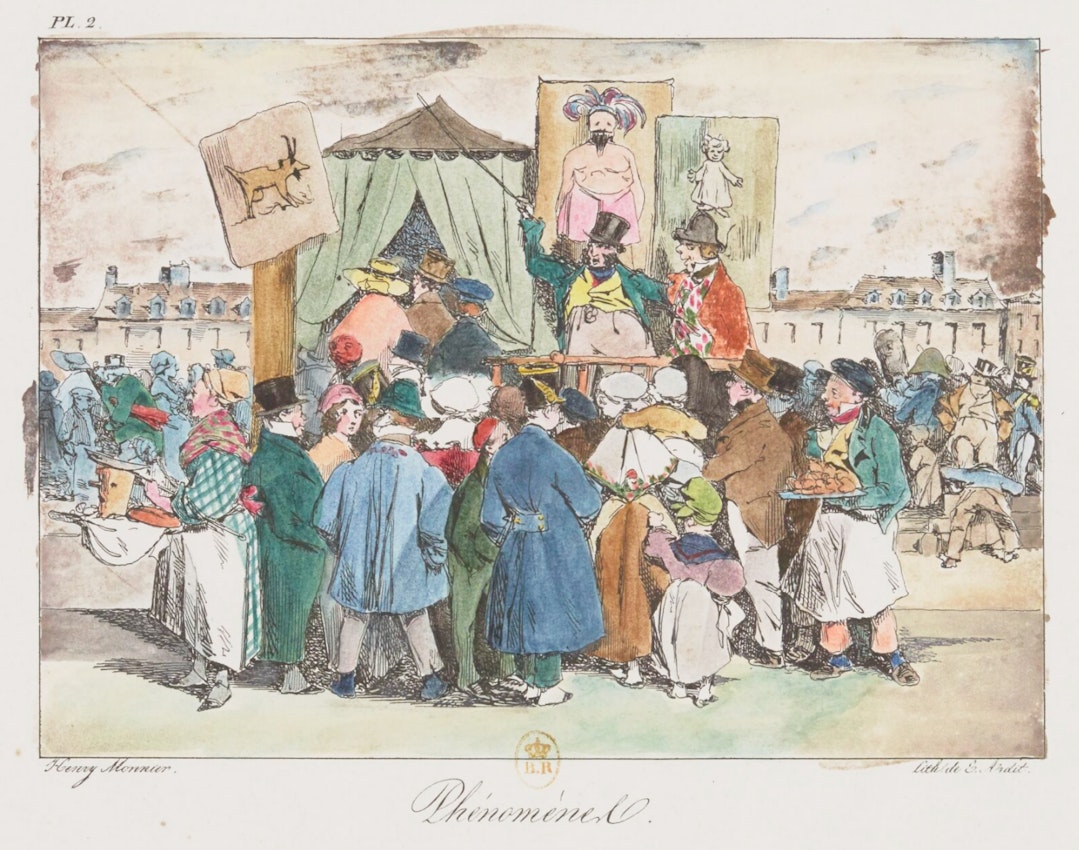 Scroll through the whole page to download all images before printing.
Scroll through the whole page to download all images before printing.
Coloured lithograph by Henry Monnier depicting a travelling circus in France, 1828 — Source.
Facing these adversities, Vidocq did what he would spend the next two decades of his life doing: he ran away again. He joined an itinerant puppet show, which quickly went awry when he was caught in flagrante with the puppet master’s wife during a performance of Punch and Judy. After a few more vagrant twists and turns, he gave up and went home — a prodigal son, remorseful but unreformed. His mother, a doting, forgiving figure who would provide one of the few constants in his life, welcomed him back with open arms. By then, however, the young Vidocq had developed a penchant for brawls, boozing, and women, so when he suggested he might join the army, his father leapt at the idea, and his mother reluctantly agreed.
Vidocq’s time in the military was short-lived, a string of desertions and regiment hops, including a brief defection to the Austrians, with whom he fought against the French, followed by a prompt return to his compatriots. This culminated in his enlistment in the armée roulante, a roving militia made up primarily of petty criminals and deserters who, with fake papers and stolen uniforms, would tack onto the regular army’s troops in the hope of one day securing an official post, and, in the short term, enjoying whatever spoils of war they could find.
Between the ages of nineteen and thirty-four, Vidocq spent most of his time in and out of prison. His first conviction — for assaulting his mistress’ other lover — led to a series of incarcerations for a variety of offences, of which just one saddled him with a lengthy, eight-year sentence. In 1798, while already imprisoned in Lille, he was found complicit in forging a release order for another inmate and condemned to spend his days toiling in the “bagne” in Brest. The galleys, notorious at the time for their appalling conditions, consisted of ships moored in ports where convicts were forced to carry out hard labour. Vidocq didn’t much care for hard labour. He escaped in disguise, first as a sailor, then a milk porter, later as a nun. Although the last of these attempts was briefly successful, he was recaptured the following year and sent to the galleys again, this time in Toulon. In the early 1800s, he escaped again, was jailed again, escaped again, leading Vidocq to boast in his memoirs of having escaped from all the galleys of France, and more than twenty prisons.
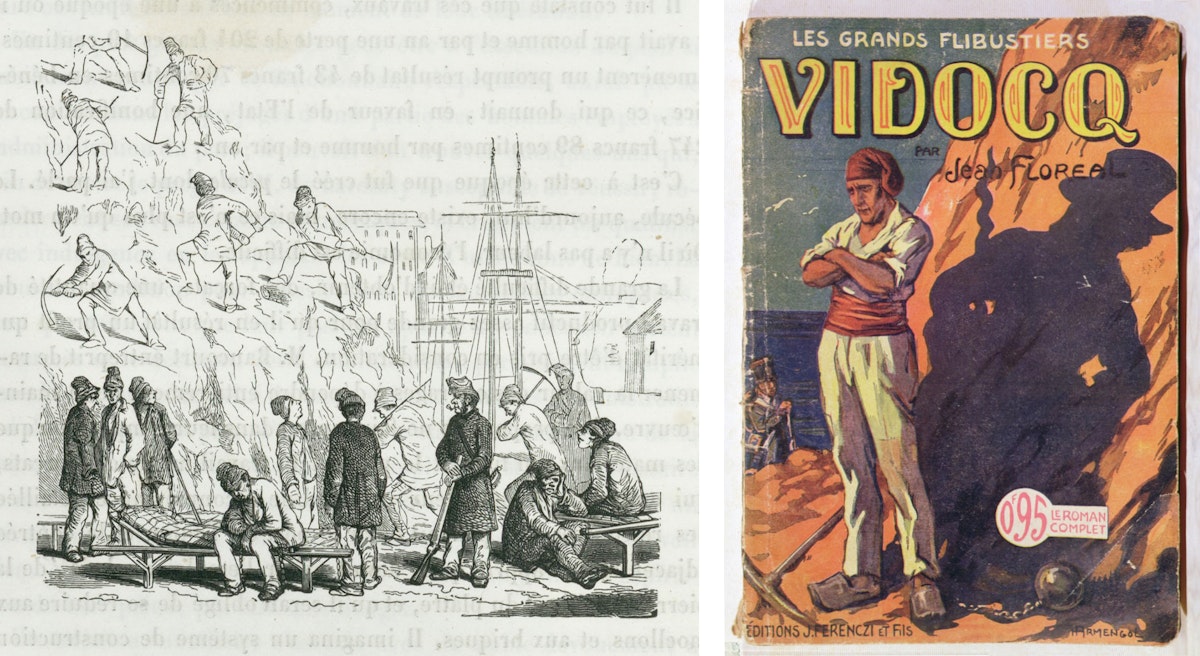 Scroll through the whole page to download all images before printing.
Scroll through the whole page to download all images before printing.
Left: an illustration of convicts forced to work in the galleys in the port of Toulon, where Vidocq was incarcerated, from Maurice Alhoy’s Les bagnes (1845). Right: the cover of Jean Floreal’s Vidocq (1925), depicting a young Vidocq at the penal colony, with his future foreshadowed behind him — Source: left, right.
Somewhere in this cycle of escape, re-arrest, re-incarceration, Vidocq decided he wanted to go straight. In 1809, then aged thirty-four and on the run in Paris, he made an unusual move: he turned himself in. It was likely at this stage that he offered to act as an informant in exchange for his liberty, a bargain frequently struck in nineteenth-century France. He wasn’t released, but he was spared another trip to the “bagnes”. He was sent to regular prison, first Bicêtre and later La Force, where, for twenty-one months, he fed information gleaned from his fellow inmates to the authorities. Vidocq must have known better than most which buttons to push to extract a confession, being well acquainted with the compulsion to brag of one’s criminal past.
The authorities were happy with his work, and in 1811, on the condition that he would continue to be an informant on the outside, they helped him stage his escape from La Force, further boosting his street credibility with the criminal gangs he was tasked with infiltrating. Within a year, he was promoted from salaried informant to the head of a newly formed unit, the Brigade de Sûreté, decreed a national security force by Napoleon in 1813.
With offices near the Paris Prefecture on Ile de la Cité, the Brigade de Sûreté began as a five-man outfit made up of Vidocq and four plainclothes, undercover agents. Together, they apprehended murderers, forgers, and thieves, seized stolen goods, and returned escaped convicts to prison. Vidocq’s officers were not paid a salary, but worked on commission, taking a fee for each successfully completed case. The arrest rate rose considerably, and within the first seven years of the Sûreté’s existence, it had, by Vidocq’s count, apprehended more than four thousand criminals.
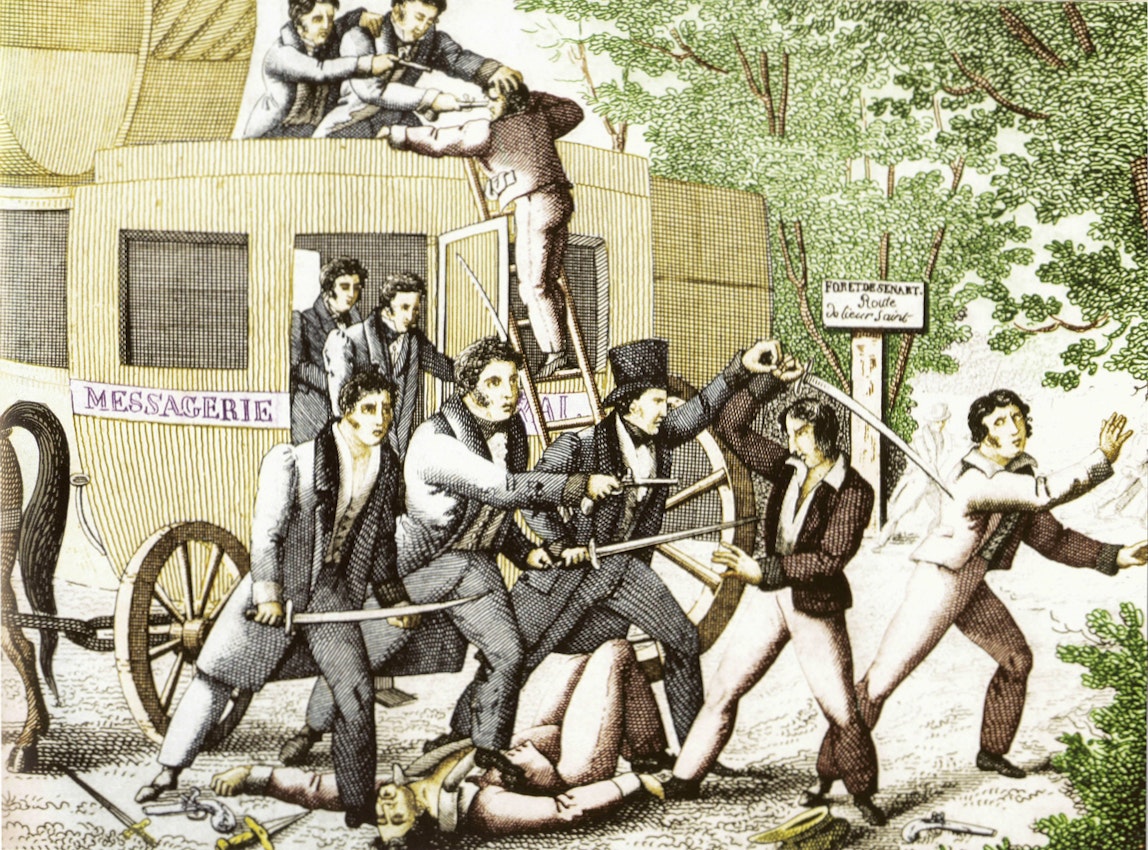 Scroll through the whole page to download all images before printing.
Scroll through the whole page to download all images before printing.
Illustration of Vidocq arresting brigands in the Forest of Sénart, Essonne, France, ca. 19th century — Source.
As the Sûreté evolved, Vidocq developed a number of policing methods still widely used today. Chief among these was the keeping of detailed written records, which may sound prosaic, but was revolutionary in its time. He maintained a card index system, with notes on some thirty thousand criminals, including physical descriptions, aliases, previous convictions, and modus operandi. That proto database, coupled with the practice of sending his agents to prisons to familiarise themselves with convicts susceptible to reoffend upon release, leant a pre-emptive, as well as reactive bent to his police work. Vidocq also lays claim to being one of the earliest proponents of forensics. At crime scenes, he would jot down seemingly irrelevant details that might later prove useful. He preserved footprints with plaster of Paris and, while unable to find an ink that dried slowly enough to take a proper impression, he recognised the forensic potential of fingerprinting long before it became a mainstay of modern policing. He compared forged notes with handwriting samples, and in a rudimentary form of ballistics (an as-yet undeveloped science), unmasked a murderer by matching bullet to gun barrel.
Thanks in part to these methods, the Brigade de Sûreté was a success, and Vidocq’s team grew steadily from four to twenty-eight agents. He recruited several women to his ranks (it took a further century for the British police to employ its first female officer, in 1915). Almost all his agents were ex-convicts. As Vidocq acknowledges in his memoirs, the end of the Napoleonic Wars in 1814–15 no doubt facilitated the Sûreté’s expansion. Out-of-work soldiers and prisoners of war flocked to the French capital and, fearing a dramatic surge in crime, the Prefecture was all too glad to increase the resources at Vidocq’s disposal. The fact that he was swelling his ranks with former criminals was not out of keeping with the zeitgeist. Paul Metzner, in a study of the sociocultural circumstances in which Vidocq’s success was forged, explores the complex and sometimes contradictory impact of the French Revolution.2 The rebels that had overthrown the existing order, only to crack down on those perceived as a threat to the newly established status quo, were both sympathetic to the ascent to power of figures from unlikely quarters, but were also acutely aware of the importance of crowd control. They recognised the value of keeping potential troublemakers on the inside.
Beyond the obvious pitfalls of working with former criminals (Vidocq had his watch stolen by one recruit, a notorious pickpocket), the Sûreté came under constant scrutiny on account of its agents’ dubious pasts. Vidocq’s superior, the head of the Paris Prefecture, Jean Henry, fielded frequent complaints that Vidocq and his team were accepting bribes, engineering crimes so as to later solve them, and profiting from the proceeds along the way. In court, defendants caught on quickly, claiming they were victims of another of Vidocq’s elaborate setups.
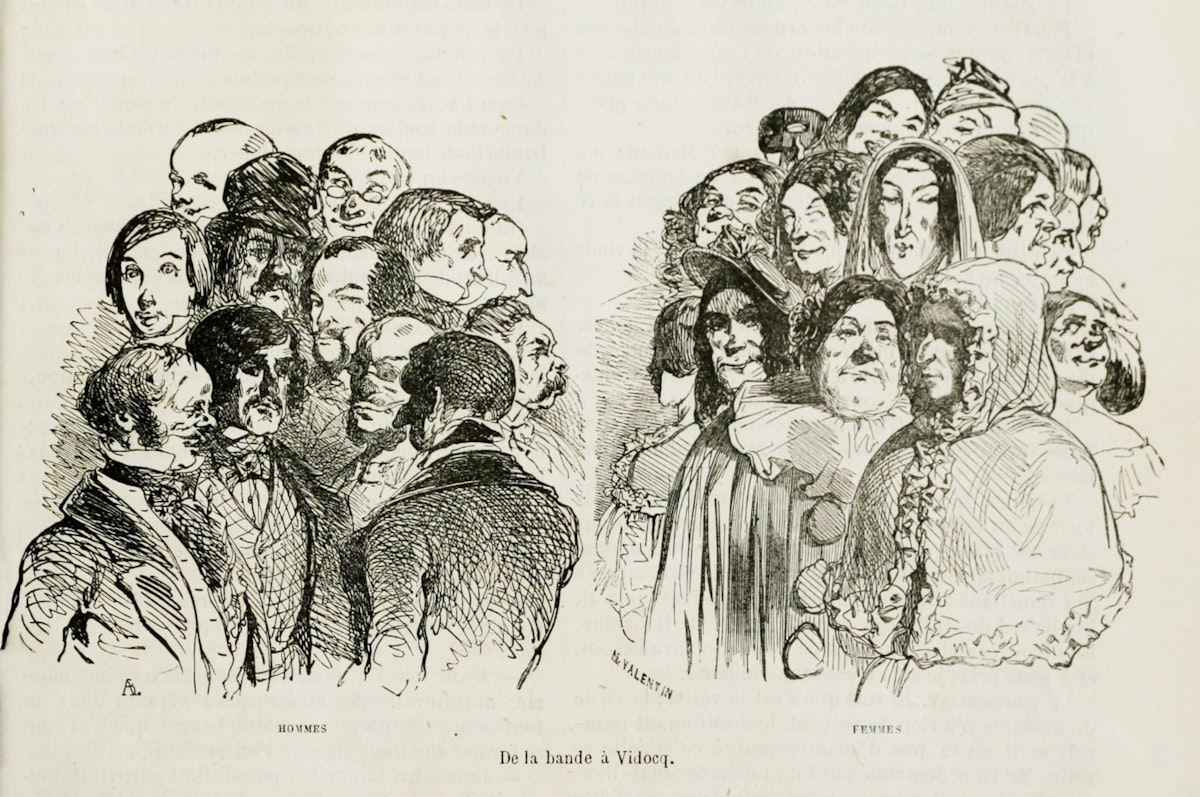 Scroll through the whole page to download all images before printing.
Scroll through the whole page to download all images before printing.
“De la bande à Vidocq”, an illustration depicting “Vidocq’s gang”, a common nickname for the Brigade de Sûreté at the time, from Mémoires de Vidocq (Paris, 1869) — Source.
In 1827, aged fifty-two, Vidocq left the Sûreté. Whether he was sacked or resigned is an open question, but in all likelihood, he jumped before he was pushed. He left a wealthy man, with half a million francs to his name. Quite how he managed this feat is unclear. His annual salary was five thousand francs, and even if he had cultivated investments on the side, his newfound wealth certainly didn’t help the rumours of unlawful enrichment.
Finding himself with time on his hands, Vidocq set to work on his memoirs, which were published in four volumes between 1828 and 1829.3 They were an instant hit, translated into English within a year, and he shot to literary stardom on both sides of the channel. This gained him new friends and dinner companions in the form of France’s greatest nineteenth-century writers — Victor Hugo, Honoré de Balzac, Alexandre Dumas père, Théophile Gautier — all of whom poached freely from Vidocq’s seemingly endless supply of tales about the criminal underworld, and the ingenious feats of detective work that outsmarted it. Metzner writes:
Crime became the object of increasing fear in the 1820s, 1830s, and 1840s, and also of increasing fascination. These were the decades when the many popular theaters founded since the 1790s began to set their violent melodramas locally rather than in exotic places. . . . Reassuringly, in melodramas the good guys always won. Likewise, in his Mémoires, detective Vidocq always got his man.4
In this respect, Vidocq’s memoirs anticipate both the emergence of the detective novel in the decades that followed and the true crime genre that continues to captivate audiences today. This double heritage is particularly apt as, in their fast-paced romp from misspent youth to later reformation, his memoirs are an audacious amalgamation of fact and fiction. The author embellishes some of his more palatable crimes — usually the “victimless” ones, or ones where he was merely avenging himself for an earlier wrong — and plays down others. In the forgery case, for which he was yet to complete his full eight-year sentence, he paints himself as a hapless bystander.
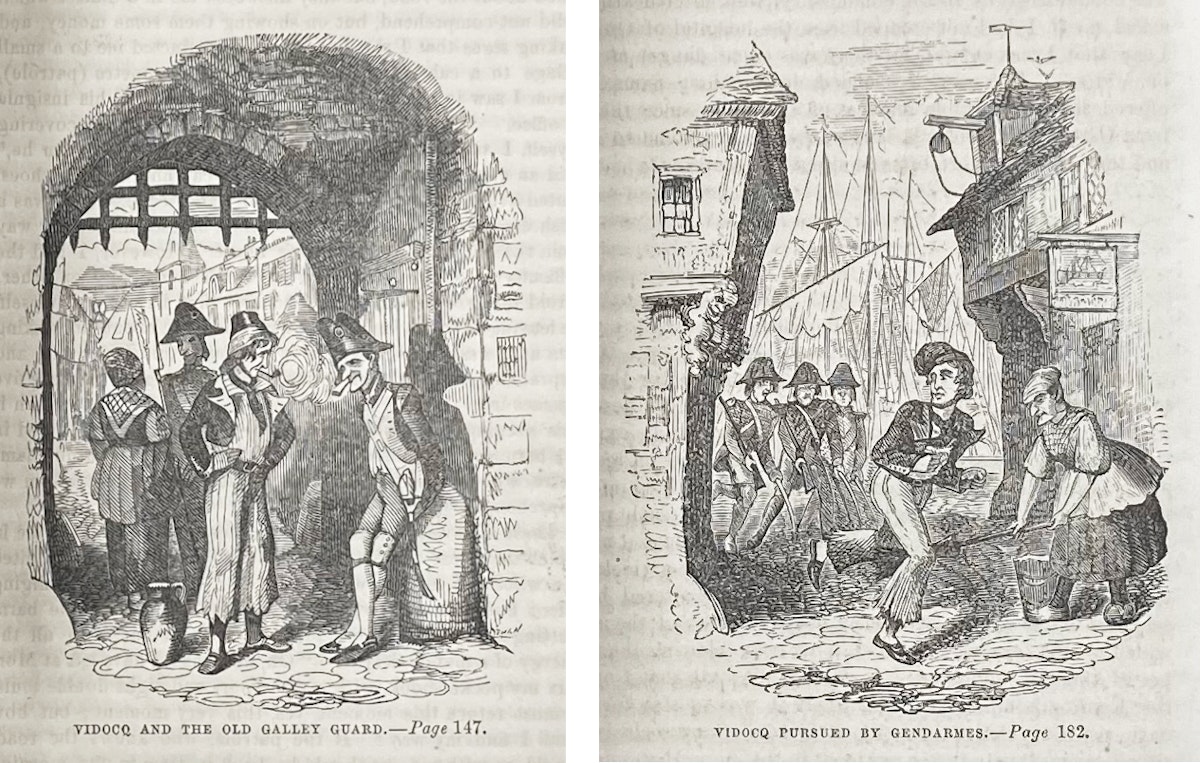 Scroll through the whole page to download all images before printing.
Scroll through the whole page to download all images before printing.
Engravings by George Cruikshank published in an 1859 English translation of the Memoirs of Vidocq. Left: “Vidocq and the Old Galley Guard”; right: “Vidocq Pursued by Gendarmes” — Source: left, right.
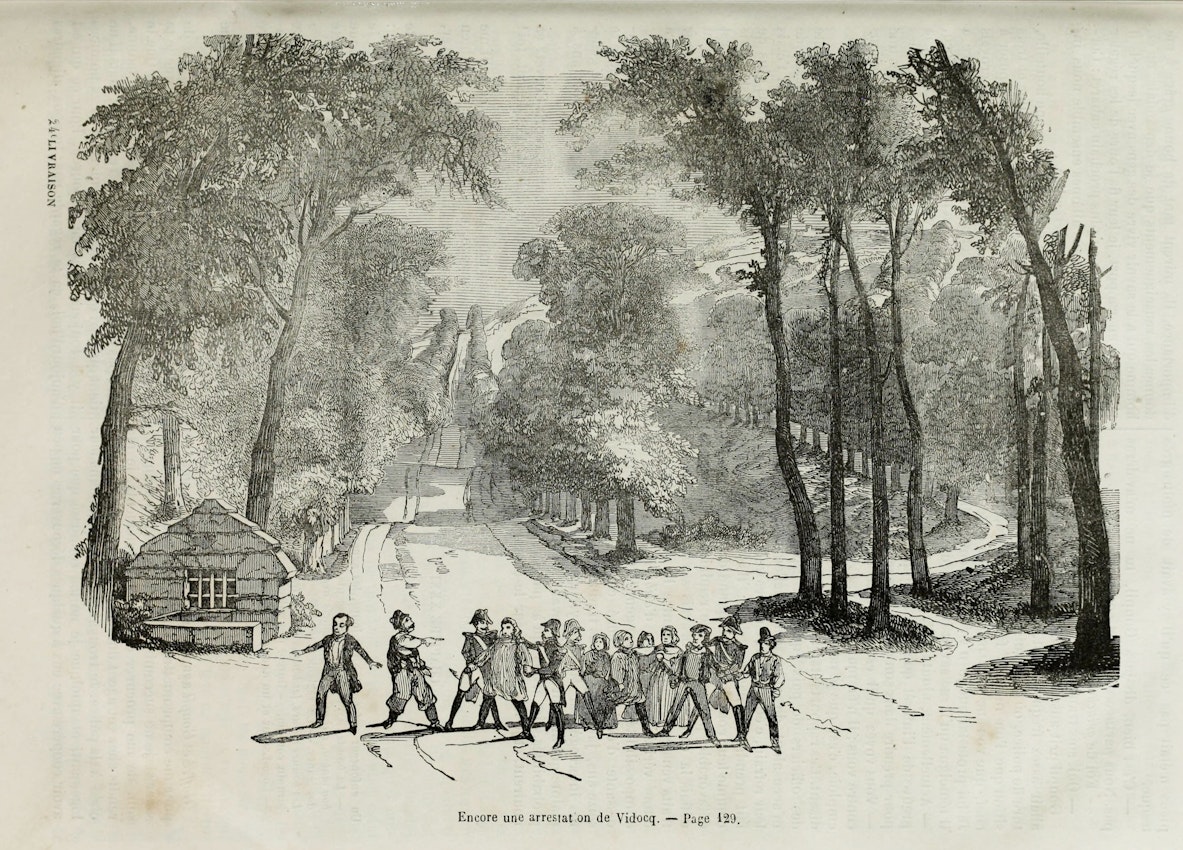 Scroll through the whole page to download all images before printing.
Scroll through the whole page to download all images before printing.
Illustration captioned “Another arrest of Vidocq”, from Mémoires de Vidocq (1869) — Source.
Vidocq’s memoirs have all the chaos and manic energy of the political period in which they took place, and perhaps their greatest appeal for a modern reader is the glimpse they offer of that era, albeit via the gaze of a distinctly unreliable narrator. They document some of the bloodiest episodes of the Reign of Terror, not least the fate of a “M. de Vieux Pont”, outed as a Royalist by his pet parrot’s cries of “Vive le roi!” and promptly guillotined. They also provide one of the most detailed contemporary accounts of the armée roulante.
The memoirs reflect the bellicose spirit of a man who found enemies, real or imagined, at every turn, leading James Morton, in his 2004 biography, to carve up Vidocq’s life into the following chapter headings: “Vidocq Against His Parents”, “Vidocq Against His Wife in Particular”, “Vidocq Against Women in General”, “Vidocq Against the Gypsies”, and so on, until we reach “Vidocq Against Death”.5 But his memoirs also contain a more considered reflection on the author’s own struggles as an ex-convict trying to clean up his act, which would turn him into, if not an altruist, then something of a social reformer. He describes the life-long sentence imposed on former convicts, outcast by ordinary society and constantly lured back to a life of crime:
[I sought] to lay down an impassable line of demarcation between the past and the present; for I saw but too plainly, that the future was dependent on the past; and I was the more wretched, as the police, who have not always due powers of discernment, would not permit me to forget myself. I saw myself again on the point of being snared like a deer. The persuasion that I was interdicted from becoming an honest man drove me to despair.6
Vidocq would later become an advocate of prison reform, travelling to London in 1835 to give evidence to a House of Lords committee on, inter alia, the problems prisoners face upon release. In 1844, he published a tract on crime and recidivism, which, to adopt Morton’s formula, could be summed up as “Vidocq Against the Justice System”.7 The tract addresses a number of questions: Does prison exist to punish or rehabilitate? What are the factors that push people into crime in the first place? What are the solutions? Vidocq’s answer to the last include improving conditions for society’s poorest; making prisons a place of re-education, where inmates can learn an honest trade; and granting them more regular contact with family members while inside to facilitate their reintegration into society upon release. Among other things, the tract takes aim at the white lead industry, one of the few sectors in which ex-convicts could find work, but which led to poisoning and premature death.
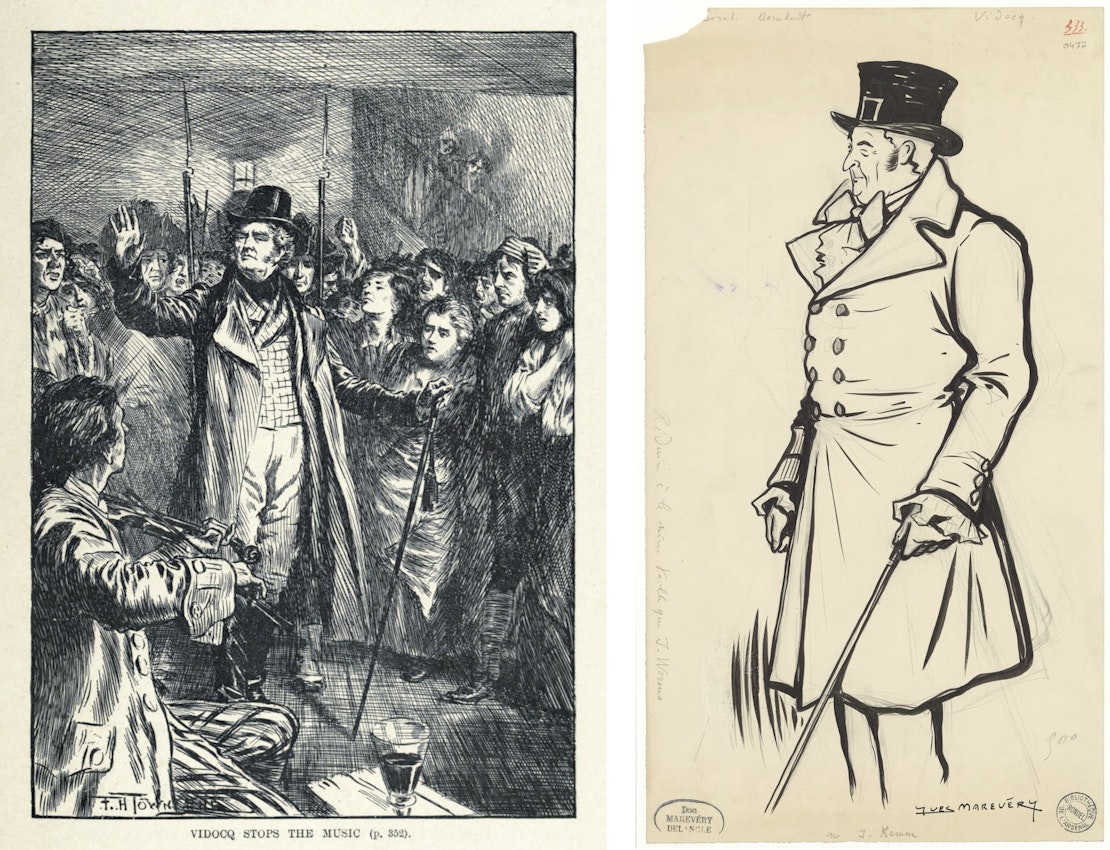 Scroll through the whole page to download all images before printing.
Scroll through the whole page to download all images before printing.
Left: an illustration from Arthur Griffth’s Mysteries of Police and Crime (ca. 1898), captioned “Vidocq Stops the Music”, depicting Vidocq clearing a tavern popular with criminals. Right: an illustration by Yves Marevéry of René Navarre in Jean Kemm’s 1923 film, Vidocq — Source: left, right.
Consequently, Vidocq embarked on another major endeavour after leaving the Sûreté. He set up a paper factory in Sainte-Mandé, a village on the outskirts of Paris, with a workforce composed exclusively of former convicts. The project was not a success. It was met with local resistance, proved costly to run, and clients refused to pay the going rates, assuming that ex-convicts meant cheaper labour, and therefore cheaper prices. The factory was forced to close. By 1831, Vidocq went bankrupt.
Fortunately, back at the Sûreté, Vidocq’s absence was palpable. According to newspapers at the time, crime rates had shot up in the wake of his departure; whether he was trustworthy or not was up for discussion, but he was certainly efficient. He returned to the fold, first as an agent, and was soon reinstated as chief. During this second tenure, Robert Peel, who had recently established Scotland Yard, sent a committee to solicit Vidocq’s advice. Within a decade, London had its own force of undercover police officers, which would eventually become the Criminal Investigation Department (CID) in 1878.
Vidocq’s second tenure lasted little more than six months. Facing widespread criticism and a push for greater transparency, the Paris Prefecture instigated a cleanup and started sacking employees with a prior criminal record. In November 1832, Vidocq was forced to resign again. A few days later, he founded what is considered by many to be the world’s first private detective agency. The Bureau de Renseignements’ remit was twofold. On the one hand, it dealt in corporate intelligence, offering debt collecting and due diligence services. Via a subscription model, companies could pay to access a database derived from the elaborate filing system Vidocq had created while at the Sûreté, allowing them to conduct background checks on prospective collaborators and clients. In tandem, the agency also dealt in what it called “intimate” or “confidential” matters. This covered everything from spying on spouses suspected of having affairs (the poet Alfred de Vigny was one such client); hunting down missing loved ones (usually daughters of respectable families who’d eloped with disreputable suitors); and recovering personal possessions (jewellery, watches, Dr Coreff’s pet cockatoo, the Mayor of Rouen’s racehorse. . .)
Vidocq, catapulted to fame by his memoirs, had no problem attracting clients, and at its peak, the Bureau de Renseignements employed some forty agents and saw over forty clients a day. Dominique Kalifa, considering the role Vidocq’s agency played in the development of the private investigation sector, mitigates the claim that it was a world first, pointing to the 250 agents d’affaires already operating in Paris in 1819, whose mission overlapped with Vidocq’s in recovered debts and advising on the solvency of potential clients.8 However, Kalifa argues, the Bureau set the mould for what a private detective agency would become. As well as combining business intelligence with personal affairs, and promoting its services in newspaper adverts, it was the first to seek to lend technical and scientific legitimacy to its work, either by importing the policing methods developed at the Sûreté, or through implementing inventions such as Vidocq’s patented indelible ink and forgery-proof paper. Above all, Vidocq, who never wasted an opportunity to play up his background as a police chief, sought to align his private enterprise with state-run law enforcement.
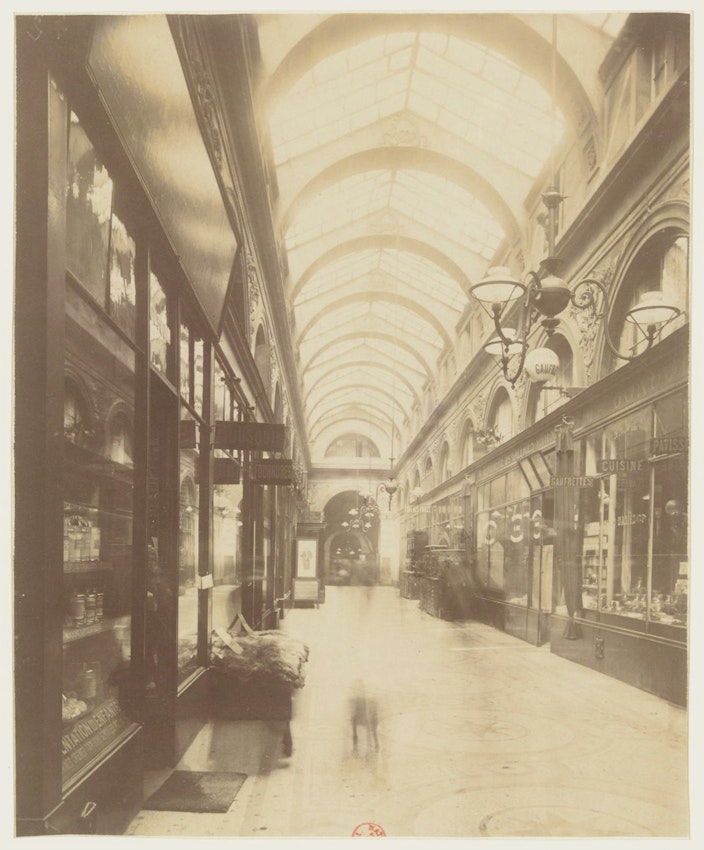 Scroll through the whole page to download all images before printing.
Scroll through the whole page to download all images before printing.
Galerie Vivienne, Paris, ca. 1906, the former location of Eugène-François Vidocq’s Bureau de Renseignements — Source.
While this was a selling point, it also had its drawbacks. The actual police, under the distinct impression that the Bureau de Renseignements was encroaching on its own territory, made repeated efforts to close it down, seizing Vidocq’s files and taking him to court in 1837 and 1843. At trial, the agency was accused of a series of offences: fraud, abduction, corruption of civil servants, defamation, pretension of public functions, usury, selling honours, stealing letters, providing substitutes for conscripts hoping to avoid military service . . . the list went on. While Vidocq was ultimately acquitted by a public jury, the lengthy and costly trials, the confiscation of his files, which formed the bedrock of his business, and the disruption to the agency’s day-to-day work took its toll. Ironically, the trials served only to cement the public’s support for Vidocq, but the damage had been done and the Bureau was forced to close.
In 1845, Vidocq travelled to London to explore the possibility of opening a new private detective agency, a project that never got off the ground. While there, an exhibition was held at the Regent Street Cosmorama, showing off his collection of crime paraphernalia, including the many disguises for which he was by then renowned. The Times wrote a glowing review, complete with a fawning portrait of the French spy chief. In the years that followed, however, the press went quiet. Vidocq fell off the radar. Letters he wrote at the time paint a bleak picture of a life of increasing poverty. In one imploring address to the new head of the Sûreté, he appeals for a government pension. It is possible that Vidocq, ever the wheeler-dealer, was playing up the extent of his misfortune; other accounts have him working as a political spy between Paris and London, monitoring the goings-on of figures like Louis-Napoleon Bonaparte.
What is known, however, is that when Vidocq died, on May 11, 1857 at the age of eighty-two, his fortune amounted to less than three thousand francs.9 This must have come as a disappointment to the eleven women who claimed to have possession of his will, in which each was identified as sole beneficiary of his estate. The obituaries came in thick and fast. One, printed in the local newspaper, L’Ariégeois, read:
The death of the famous Vidocq, head of the Sûreté police under the restoration, has been announced in Paris. Since his dismissal, he sought resources from a variety of random industries: for a handsome salary, he spied on husbands for their wives, and wives for their husbands; he also opened an office to track down stolen goods, but whatever his skill and his connections with the capital's crooks, he often failed to find the thieves and nonetheless pocketed the money he had been given to pursue them. Despite this, or perhaps because of it, he died in a very miserable state.10
Other write-ups were more generous. Alphonse de Lamartine, the Romantic poet and politician who briefly headed the French government, said of his close friend and fellow opponent of the death penalty: “I liked him, I respected him . . . I learnt, when I was in power, that he was a loyal and trustworthy servant; I will never forget him, and I can proudly say he was an honest man!”11
Lamartine never put Vidocq in his fiction, but his contemporaries did, thus ensuring an enduring legacy on the page. While he made his way into some of the most canonical works of nineteenth-century literature, providing one of the inspirations for Magwitch in Charles Dickens’ Great Expectations (1861) for instance, he also found a home in the “dime novels” that flourished on the other side of the Atlantic in the ensuing decades. In 1877, pulp fiction pioneers Beadle and Adams published an abridged translation of his Mémoires, “Vidocq, the French Police Spy”, in their characteristic ten-cent, paperback format. Presumably spurred on by its success, they continued to wheel out the cunning detective in a series of fictional reincarnations: “Dodger Dick, the Boy Vidocq” (1888), “Happy Hans, the Dutch Vidocq” (1889), “Old Cormorant, the Veteran Vidocq” (1889) and “Violet Vane, the Ventriloquist Vidocq” (1891). Since then, he has been the hero of a dozen graphic novels, made a guest appearance in the video game Assassin’s Creed, and enjoyed a long afterlife on screen, from Gérard Bourgeois’ silent, black-and-white film, La jeunesse de Vidocq ou Comment on devient policier (1909) to Jean-François Richet’s L’Empereur de Paris (2018), starring a bloody, brawling Vincent Cassel as the French police chief.
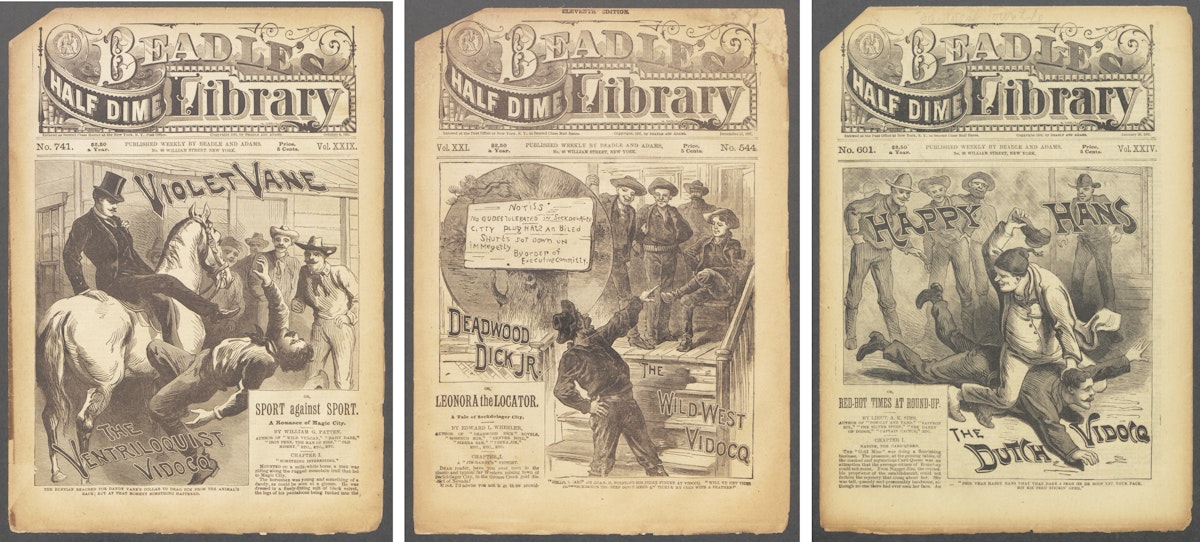 Scroll through the whole page to download all images before printing.
Scroll through the whole page to download all images before printing.
Covers for a series of Vidocq stories — “The Ventriloquist Vidocq” (1891), “The Wild-West Vidocq” (1887), “The Dutch Vidocq” (1889) — published by Beadle’s Half Dime Library — Source: left, centre, right.
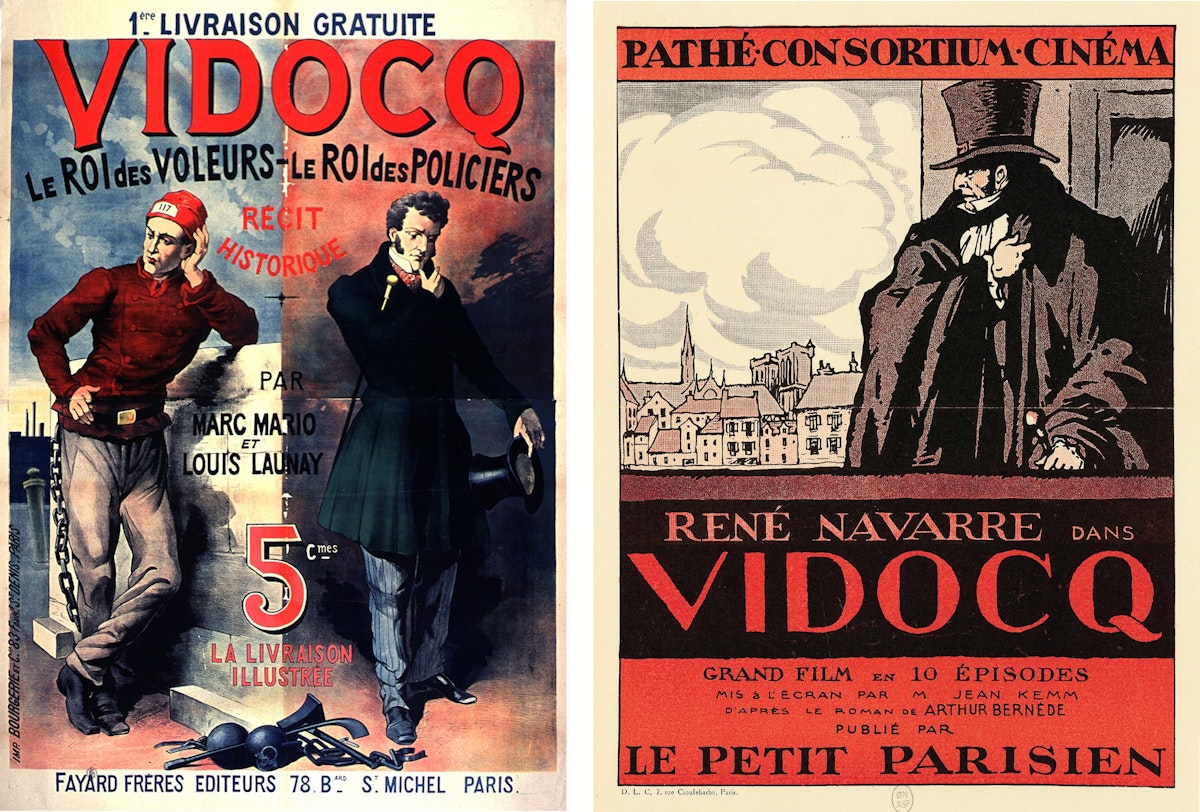 Scroll through the whole page to download all images before printing.
Scroll through the whole page to download all images before printing.
Left: a lithograph for the 1892 historical novel Vidocq, le roi des voleurs, le roi des policiers (Vidocq, king of thieves, king of the police) by Marc Mario and Louis Launay. Right: a poster for the 1923 film Vidocq, directed by Jean Kemm and starring René Navarre — Source: left, right.
If Vidocq’s legacy was contested at his death, it continues to be so today. He enjoys a cult-like status among certain criminologists, not least the members of the Vidocq Society, an American organisation where forensic experts, detectives, FBI agents, and amateur sleuths get together to solve cold cases, inspired by “the father of modern criminal investigation”.12 For Michel Foucault, however, he represents “the disturbing moment when criminality became one of the mechanisms of power.”13 Echoing this, Graham Robb, reviewing a 2003 re-edition of Vidocq’s memoirs, applauds editor Robin Walz’s new preface which presents Vidocq “as a forerunner of the ‘scammers and scoundrels’ in giant American corporations who profit from state-funded violence and who advertise their greed as a self-righteous war on evil.” “It is nice to see”, Robb continues, “that, after a century and a half of misinformed adulation, Vidocq is finally getting his just deserts.”14
For a man known in his lifetime as a master of disguise, capable of appearing several inches taller or shorter than he really was, it is fitting that today Vidocq lives on in a hundred different iterations, each a projection of what the beholder wishes to see. Hero, antihero, showman, shapeshifter: in the absence of independently verifiable truth, Eugène-François Vidocq will be whatever you want him to be.
Daisy Sainsbury is a British writer and translator based in Paris. She completed a PhD and post-doctoral research fellowship in French literature at the University of Oxford and is the author of Contemporary French Poetry (Legenda, 2021). She has written short stories, reviews and essays for publications such as Literary Review, ArtReview, Wasafiri, 3:AM Magazine and The London Magazine, and is currently working on her first novel.